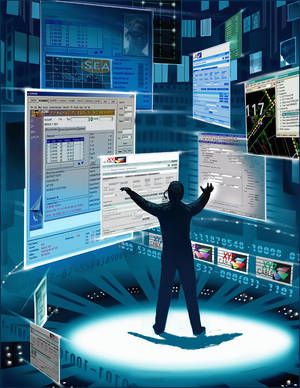A prediction is a statement about the way things will happen in the future. Outside the rigorous context of science, prediction is often confused with informed guess or opinion. A prediction of this kind might be inductively valid if the predictor is a knowledgeable person in the field and is employing sound reasoning and accurate data. In many applications it is possible to estimate the models that generate the observations. If models can be expressed as transfer functions or in terms of state-space parameters then smoothed, filtered and predicted data estimates can be calculated.
Affordable home computers powerful enough to predict at least some aspects of the future may soon be available, according to scientists at Los Alamos National Laboratories.
Now, don't get your hopes too high, because the Los Alamos scientists are not working on computers capable of foreseeing winning lottery numbers. "We want to predict the future because we want to make good decisions, from wearing the right clothes for the weather to evacuating people from danger," said Andy White of the Laboratory's Computer and Computational Science Division.
White plans to examine the last hundred years of progress in predicting the future, emphasizing computer models of weather and wildfires. "The next best computers may originate from a surprising source and their predecessors might be in your home today," White said.
Meanwhile a paper published September in the peer-reviewed journal First Monday combines advanced supercomputing with a quarter-century of worldwide news to forecast and visualize human behavior, from civil unrest to the movement of individuals.
The paper, titled "Culturomics 2.0: Forecasting Large-Scale Human Behavior Using Global News Media Tone in Time and Space," uses the tone and location of news coverage from across the world to forecast country stability (including retroactively predicting the recent Arab Spring), estimate Osama Bin Laden's final location as a 200-kilometer radius around Abbottabad, and uncover the six world civilizations of the global news media. The research also demonstrates that the news is indeed becoming more negative and even visualizes global human societal conflict and cooperation over the last quarter century.

While most mobile phones use a predictive text algorithm to finished sentences. Jeff Hawkins founder of Palm Computing, has a theory that human intelligence can be defined as the ability to see patterns and predict outcomes based on previous experiences. Human brains build a model of the world from our experiences and based on this model we are able to make theories and predictions about the future. In essence the brain is a prediction machine, which could in theory be replicated into a silicon computer.
Numenta is the company founded by Hawkins in 2005 to commercialize and spread the breakthroughs of his many years of theoretical brain research.
With cognitive computers around the corner based on the human brain to sense and recognize patterns to make predictions, the possibilities to see the future may become a reality. One application could be in the form of precrime and look for clues into homicide.
Using Newark, N.J., as a pilot case, a team of Michigan State University researchers led by April Zeoli successfully applied public health tracking methods to the city's 2,366 homicides between 1982 and 2008. They found the killings were not randomly located but instead followed a pattern, evolving from the city's center and moving southward and westward over time. Like a flu bug that spreads to susceptible groups such as children and the elderly, homicide clusters in Newark often fueled by gangs and guns spread to areas consisting largely of poor and minority residents. Over time, the concentration of homicides effectively disappeared from one area and settled in another.
"By using the principles of infectious disease control, we may be able to predict the spread of homicide and reduce the incidence of this crime," said Zeoli, public health researcher in MSU's School of Criminal Justice. The study is one of the first to use analytic software from the field of medical geography to track long-term homicide trends. Zeoli said the method can be done in real time which would allow police to identify emerging hotspots. The researchers also identified areas of Newark that had no homicide clusters during the 26-year time frame of the study, despite being surrounded by deadly violence. "If we could discover why some of those communities are resistant," Zeoli said, "we could work on increasing the resistance of our communities that are more susceptible to homicide." The study is published in Justice Quarterly, a research journal.
An alternative system could be analyzing how many calls someone makes to a friend, and by correlating human movement patterns, the researchers can predict anyones movements over the next 24 hours even if you deviate dramatically from routine. On the nefarious end of the spectrum, though, this algorithm could be the cornerstone of a Precrime Police Division, a la Minority Report. Precrime would track the location of known criminals via their smart phones or street cameras, and put a tap on their calls to correlate their movements with their friends/known associates.
As part of an update to the national fingerprint database, the FBI has begun rolling out facial recognition to identify criminals. It will form part of the bureau's long-awaited, $1 billion Next Generation Identification (NGI) programme, which will also add biometrics such as iris scans, DNA analysis and voice identification to the toolkit. A handful of states began uploading their photos as part of a pilot programme this February and it is expected to be rolled out nationwide by 2014. In addition to scanning mugshots for a match, FBI officials have indicated that they are keen to track a suspect by picking out their face in a crowd.
The next generation of computer systems will be able to data crunch massive amounts of information to spot patterns and predict the possible futures. While the human element of street camera operators in England have limited success in recognizing suspicious characters, its likely that tracking data and profiling criminals will become similar to electronic tags.
As social media has tracking cookies attached to your browser, the equivalent tracker could be your phone or every electronic interaction. The modern version of a electronic eye watching over us, depicted in films and various dystopian ideologies may have a a glimmer of truth. The reality is that such super computers are too expensive to run or to make in the application for predicting crime. But as the cost comes down and technology makes greater leaps. The high tech surveillance systems once monitoring terrorists and international criminals may filter down to the domestic level, of local crime as a economical advantage over man power used in police detection...







No comments:
Post a Comment